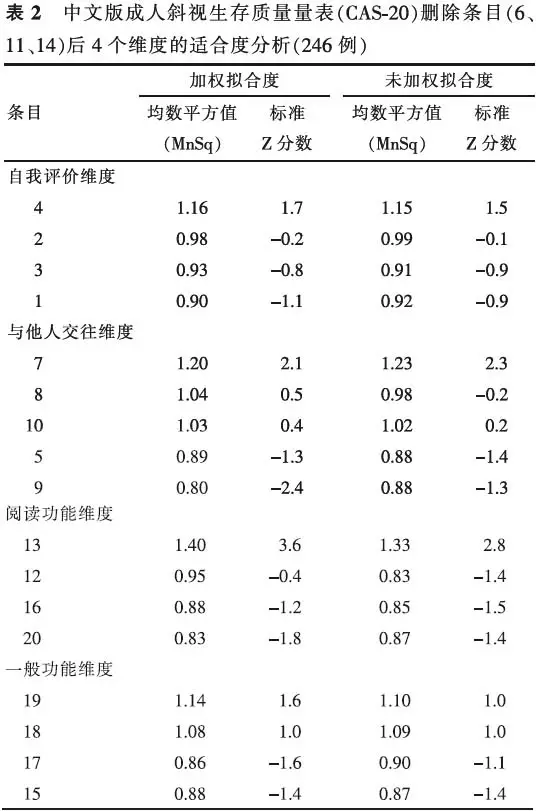【摘要】 目的 通过Rasch分析提炼中国成人斜视生存质量量表(CAS-20),以能更好地用于评估成人斜视患者的生存质量状况。方法 横断面研究。246例成人斜视患者,独立完成CAS-20问卷调查。根据量表每一条目的得分情况进行Rasch分析,分析条目及答案的心理计量特征。分析的项目包括分解维度、选项排序、局部独立性、适合度指标、项目差别功能、项目适中性分析、最终确定维度等。结果 原CAS-20包括2个维度,为“社会心理维度”和“视觉功能维度”。通过Rasch分析可将量表分为4个维度,分别为“自我评价”、“与他人交往”、“阅读功能”和“一般功能”。原先的选项排序对每个维度均非常合理。每个维度的各条目之间标准残差相关系数均<0.7,说明同一维度内条目之间具有一定的独立性。通过适合度指标分析,除“与他人交往”维度外,其他3个维度均需剔除1个条目。项目差别功能分析提示年龄和性别在4个维度中均无明显差异。项目适中性分析发现项目难度和研究对象个体能力之间匹配较好,阅读功能维度条目相对于患者个体能力来说略为简单。结论 CAS-20通过Rasch分析,20个条目缩减为17个条目,并且分为4个维度,分别是“自我评价”、“与他人交往”、“阅读功能”和“一般功能”,每个条目的选项仍为5个。优化的CAS-20可以更敏感地反映中国成人斜视患者的生存质量状态。
【关键词】 Rasch分析; 成人斜视生存质量量表; 维度; 斜视
Evaluation of the Chinese Adult Strabismus-20 (CAS-20) questionnaire using Rasch analysis
Xu Meiping, Zheng Jingwei, Yu Xinping, Chen Yuanyuan, Yu Huanyun. Eye Hospital of Wenzhou Medical University, Wenzhou 325027, China
Corresponding author: Zheng Jingwei, Email: jingwei327@gmail.com
【Abstract】 Objective To further refine the Chinese Adult Strabismus-20 (CAS-20) health-related quality of life(HRQOL) questionnaire using Rasch analysis. Methods In this cross-sectional study, the CAS-20 questionnaire was independently completed by 246 adult strabismus patients. Based on the score for each item, Rasch analysis was performed on the original CAS-20 using the following aspects: dimensionality, response order, local dependence, infit and outfit analysis, differential item function, subject targeting and confirmatory dimensionality. Results The original CAS-20 was divided into 4 subscales, which were labeled ″self-perception″, ″interaction″, ″reading function″, and ″general function″. Response ordering was appropriate for all of the 4 subscales. As a result of infit and outfit analysis, 3 items were removed, one each from ″self-perception″, ″reading function″, and ″general function″. No significant differential item function was found for sex or age. Compared with the ability of the patients and item difficulty, the 3 subscales matched well except for ″reading function″. Conclusion The original CAS-20 was reduced to 17 items, and divided into 4 subscales, which were ″self-perception″, ″interaction″, ″reading function″, and ″general function″. Subject response choices saved 5 test options. The refined CAS-20 may prove to be more responsive to HRQOL changes in adult strabismus patients.
【Key words】 Rasch analysis; Adult strabismus health related quality of life questionnaire; Subscale; Strabismus
DOI:10.3760/cma.j.issn.1674-845X.2015.04.008
基金项目:温州市科技局科研基金项目(Y20140376);卫生部卫生行业科研专项基金(20130215)
作者单位:325027 斜弱视专科
通信作者:郑景伟,Email:jingwei327@gmail.com







